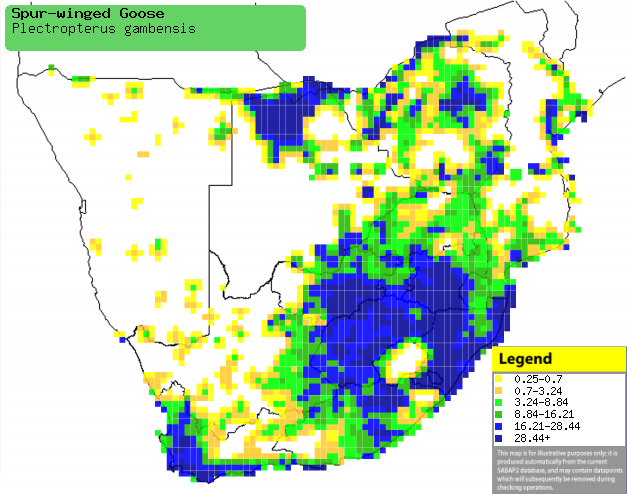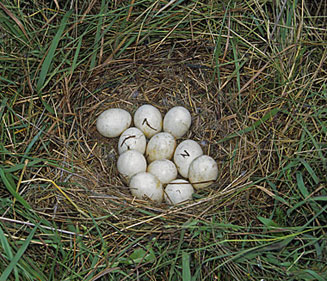|
Plectropterus gambensis
(Spur-winged goose)
Wildemakou [Afrikaans]; Ihoye [Xhosa]; iHophe (also used
for Redeyed and Cape turtle doves -check), iHoye [Zulu]; Esokwe [Kwangali];
Letsikhoi, Letsikhui [South Sotho]; Sekwagongwana, Sekwanyarhi [Tsonga]; Legôu
(also applied to Egyptian goose), Letsikwe [Tswana]; Spoorwiekgans [Dutch];
Oie-armée de Gambie [French]; Sporengans [German]; Pato-ferrão [Portuguese]
Life
> Eukaryotes >
Opisthokonta
> Metazoa (animals) >
Bilateria >
Deuterostomia > Chordata >
Craniata > Vertebrata (vertebrates) > Gnathostomata (jawed
vertebrates) > Teleostomi (teleost fish) > Osteichthyes (bony fish) > Class:
Sarcopterygii (lobe-finned
fish) > Stegocephalia (terrestrial
vertebrates) > Tetrapoda
(four-legged vertebrates) > Reptiliomorpha > Amniota >
Reptilia (reptiles) >
Romeriida > Diapsida > Archosauromorpha > Archosauria >
Dinosauria
(dinosaurs) > Saurischia > Theropoda (bipedal predatory dinosaurs) >
Coelurosauria > Maniraptora > Aves
(birds) > Order: Anseriformes
> Family: Anatidae
The largest duck or goose in Africa, weighing up to
7.45 kg. Widely distributed in Sub-Saharan Africa and with broad habitat
preferences. Eats mainly plant matter, either from in and around water bodies or
on dry land (seedlings and grain from crop lands are a favourite, which make
them unpopular with farmers) . However, they do eat insects (e.g. termite
alates) and young are known to catch and eat small fish.
Records
By far the largest and heaviest duck or goose species in
Africa. The next heaviest is the Egyptian
goose at a maximum weight of 3.01 kg.
|
Heaviest adult female |
6.10 kg |
|
Heaviest adult male |
7.45 kg |
|
Lightest adult female |
2.20 kg |
|
Lightest adult male |
3.30 kg |
|
Longest living |
7 yrs 9 months |
|
Longest distance travelled |
686 km |
Distribution and habitat
Found through most of the Sub-Saharan region. Widespread
in southern Africa but absent to sporadic in semi-arid and arid regions. Can be
found on virtually any internal water body and also encountered in grassland,
karoo and on crop fields.
|
 |
|
Distribution of Egyptian goose in southern Africa,
based on statistical smoothing of the records from first SA Bird Atlas
Project (©
Animal Demography unit, University of
Cape Town; smoothing by Birgit Erni and Francesca Little). Colours range
from dark blue (most common) through to yellow (least common).
See here for the latest distribution
from the SABAP2. |
Predators and parasites
- Ectoparasites (parasites on the outside of the body)
- Hexapoda (insects) > Malophaga (lice) >
feather lice
- Holomenopon tumidum
- Acidoproctus taschenbergii
- Anatoecus icterodes
- Anaticola asymmetricus
- Trinoton gambensis
- Hexapoda (insects) >
Diptera (flies) >
Hippoboscidae
- Arachnida (arachnids) > Acarina (mites and
ticks)
- nasal mites
- feather mites
- Bdellorhynchus psalidurus
- ticks
- Endoparasites (parasites inside the body)
- schistosomes
- Gigantobilharzia plectropteri
- Trichobilharzia spinulata
- Trichobilharzia - 3 other species
- Pathogens
- Clostridium botulinum Type C: only one case
reported - unlikely to be highly prevelant because of plant-dominated
diet.
Food
- Water-based foraging:
- plant matter constitutes the bulk of the diet:
- Potamogeton pectinatus (Sago pondweed):
eats the rhizomes, stolons, leaves
- Potamogeton crispus (Wavy-leaved
pondweed)
- Typha latifolia (bulrush): eats the
shoots
- Phragmites australis (Common reed): eats
the shoots
- Juncellus laevigatus (sedge): eats the
seeds
- Alisma plantago (Water plantain)
- Stigeoclonium (filamentous alga)
- animal matter
- young birds dive for small fish and eat them
- Land-based foraging:
- plant matter constitutes the bulk of the diet
- Seeds, leaves, corms of grass (Poaceae)
- Urochloa panicoides (Signal grass)
- Cynodon dactylon (Couch grass)
- Eleusine indica (Goose grass)
- Panicum repens (Couch panicum)
- from cultivated fields
- ripe kernels and seedlings of grain crops
(not popular with the farmers)
- maize
- wheat
- oats
- barley
- sorghum
- lucerne
- potatoes
- sweet potatoes
- peanuts
- sunflower seeds
- rice
- animal matter
Breeding
- Pair bond does not last long: male generally moves off
once the young have hatched, but before this he devotes some attention to
protecting the breeding territory.
 |
|
|
Spur-winged goose nest with eggs, Wakkerstroom,
South Africa. [photo
Warwick Tarboton ©] |
|
- Nest is placed in a shallow scrape in the ground and
consists of a bowl of grass, reed stems and other plant material collected
by the female in the vicinity and lined with her down. The nest is usually
placed in dense grass or reeds on an elevated piece of land near water
(e.g. an embankment, island, termite heap). However, also known to
nest in Aardvark (Orycteropus afer) burrows (like South
African Shelduck) or up to 16 m above the ground in tree bole or on the
vacated large nest of a Hamerkop, Sociable
weaver, Martial
eagle or African
fish-eagle.
- Breeding season (laying dates). Any time of year
- The female lays 7-14 eggs and on clutch completion,
incubates them for 30-31 days before they hatch. Clutches of up to 27 have
been recorded but these are thought to be the result of laying by more than
one female. The female leaves the nest to feed in the early morning and/or
in the late afternoon, and while she is away from the nest, she leaves the
eggs covered with down to protect them and to keep them warm.
- Young leave the nest soon after hatching and are cared
for only by the female. They have developed their flight feathers (i.e. they
have fledged) by about 85 days old and are able to fly soon after (earliest
record of first flight is 100 days).
Threats
- Unpopular with grain farmers, but its negative effect on agricultural production is usually minimal. However this
does expose it to being shot by farmers.
- Hunters like shooting them because of their large size.
However, this has had a negligible effect on populations, except perhaps in
Botswana.
- Overall, the Spurwing goose has expanded its
distribution and density because of the building of dams and increased food
supply (crops).
References
-
Hockey PAR, Dean WRJ and Ryan PG (eds) 2005. Roberts
- Birds of southern Africa, VIIth ed. The Trustees of the John Voelcker
Bird Book Fund, Cape Town.
|
